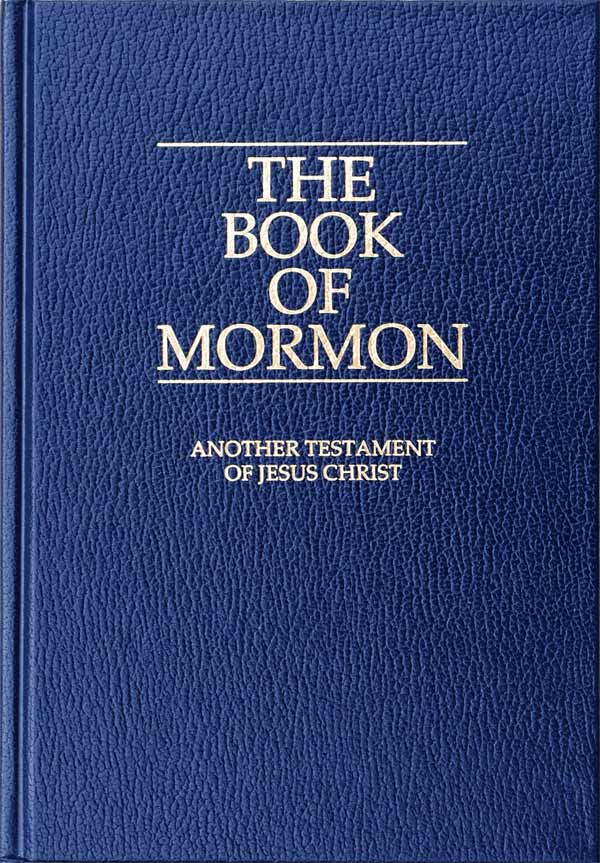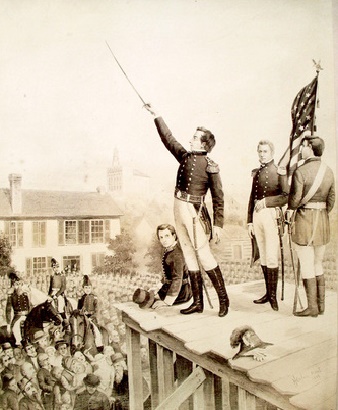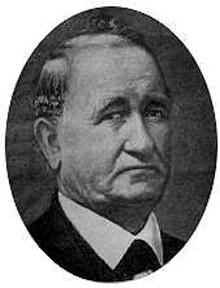|
Battle Creek Massacre
The Battle Creek massacre was a massacre on March 5, 1849, by Mormon settlers of Timpanogo natives at Battle Creek (near present-day Pleasant Grove, Utah). The ambushed Timpanogos were outnumbered and outgunned and had no defense against the militia that crept in and surrounded their camp before dawn. Mormon settlement of Utah Valley came upon the heels of the attack at Battle Creek. Background Around February 1849, Dimick B. Huntington spoke with Timpanogo leader Little Chief about some of the settlers' missing cattle. Little Chief said that Roman Nose and Blue Shirt were great thieves who had decided to live off of the settlers' cattle all winter. Little Chief said that the Mormons should kill these renegades, perhaps out of fear that his tribe would be blamed and killed for the missing cattle. On March 1 Captain John Scott took fifty militiamen into Utah Valley to investigate the theft of horses from Brigham Young's herd. They were under orders "to take such measures as wo ... [...More Info...] [...Related Items...] OR: [Wikipedia] [Google] [Baidu] |
Mormons
Mormons are a Religious denomination, religious and cultural group related to Mormonism, the principal branch of the Latter Day Saint movement started by Joseph Smith in upstate New York during the 1820s. After Smith's death in 1844, the movement split into several groups following different leaders; the majority followed Brigham Young, while smaller groups followed Joseph Smith III, Sidney Rigdon, and James Strang. Most of these smaller groups eventually merged into the Community of Christ, and the term ''Mormon'' typically refers to The Church of Jesus Christ of Latter-day Saints membership statistics, members of the Church of Jesus Christ of Latter-day Saints (LDS Church), as today, this branch is far larger than all the others combined. People who identify as Mormons may also be independently religious, secular, and non-practicing or belong to List of denominations in the Latter Day Saint movement, other denominations. Since 2018, the LDS Church has requested that its memb ... [...More Info...] [...Related Items...] OR: [Wikipedia] [Google] [Baidu] |
Mountain Man
A mountain man is an explorer who lives in the wilderness. Mountain men were most common in the North American Rocky Mountains from about 1810 through to the 1880s (with a peak population in the early 1840s). They were instrumental in opening up the various emigrant trails (widened into wagon roads) allowing Americans in the east to settle the new territories of the far west by organized wagon trains traveling over roads explored and in many cases, physically improved by the mountain men and the big fur companies originally to serve the mule train based inland fur trade. Mountain men arose in a natural geographic and economic expansion that was driven by the lucrative earnings available in the North American fur trade, in the wake of the various 1806–07 published accounts of the Lewis and Clark Expedition findings about the Rockies and the Oregon Country where they flourished economically for over three decades. By the time two new international treaties in early 1846 and e ... [...More Info...] [...Related Items...] OR: [Wikipedia] [Google] [Baidu] |
Timpanogos Tribe
The Timpanogos (Timpanog, Utahs or Utah Indians) were a tribe of Native Americans who inhabited a large part of central Utah, in particular, the area from Utah Lake east to the Uinta Mountains and south into present-day Sanpete County. Most Timpanogos live on the Uintah Valley Reservation. They are enrolled in the Ute Indian Tribe of the Uintah and Ouray Reservation. During the mid-19th century, when Mormon pioneers entered Utah territory, the Timpanogos were one of the principal tribes in the region based on population, area occupied, and influence. Linguists have had difficulty identifying (or classifying) their language. Historically, most communication was carried out in Spanish or English, and many of their leaders spoke several dialects of the Numic branch of the Uto-Aztecan language family. While the Timpanogos are typically classified as Ute people, they may have been a Shoshone band. Other Shoshone bands occupied parts of Utah, and historian Hubert Howe Bancroft wro ... [...More Info...] [...Related Items...] OR: [Wikipedia] [Google] [Baidu] |
The Church Of Jesus Christ Of Latter-day Saints In Utah
The Church of Jesus Christ of Latter-day Saints in Utah refers to the Church of Jesus Christ of Latter-day Saints (LDS Church) and its members in Utah. Utah has more church members than any other U.S. state or country. The LDS Church is also the largest denomination in Utah. History A brief history can be found at the church'Newsroom (Utah)oDeseret News 2010 Church Almanac Membership history Though membership in Utah has increased, the percentage of Utahns who are Latter-day Saints has declined. Much of this is due to the rapid growth of the state. In 2008, the US Census Bureau determined Utah to be the fastest growing state in the country in terms of population growth. County statistics 150px, Counties of Utah by percentage of Latter-day Saint adherence List of LDS Church adherents in each county as of 2010 according to the Association of Religion Data Archives: Missions Due to nonmembers coming into the state, Utah officially became a mission field with its own he ... [...More Info...] [...Related Items...] OR: [Wikipedia] [Google] [Baidu] |
Mormonism And Native Americans
Mormonism is the religious tradition and theology of the Latter Day Saint movement of Restorationist Christianity started by Joseph Smith in Western New York in the 1820s and 1830s. As a label, Mormonism has been applied to various aspects of the Latter Day Saint movement, although there has been a recent push from the Church of Jesus Christ of Latter-day Saints (LDS Church) to distance themselves from this label. A historian, Sydney E. Ahlstrom, wrote in 1982, "One cannot even be sure, whether ormonismis a sect, a mystery cult, a new religion, a church, a people, a nation, or an American subculture; indeed, at different times and places it is all of these." However, scholars and theologians within the Latter Day Saint movement, including Smith, have often used "Mormonism" to describe the unique teachings and doctrines of the movement. A prominent feature of Mormon theology is the Book of Mormon, which describes itself as a chronicle of early indigenous peoples of the Americas ... [...More Info...] [...Related Items...] OR: [Wikipedia] [Google] [Baidu] |
Mormonism And Violence
Mormons have both used and been subjected to significant violence throughout much of the religion's history. In the early history of the United States, violence was used as a form of control. Mormons were violently persecuted and pushed from Ohio to Missouri, from Missouri to Illinois and from Illinois, they were pushed west to the Utah Territory. There were incidents of massacre, home burning and pillaging, followed by the death of their prophet, Joseph Smith. Smith died from multiple gunshot wounds from a lynch mob at a jail in Carthage, Illinois; Smith had defended himself with a small pistol smuggled to him by church leader Cyrus Wheelock and he was then shot while trying to flee from a window. There were also notable incidents in which Mormons perpetrated violence. Under the direction of Mormon prophets and apostles, the Mormon burned and looted Davies County, attacked and killed a member of the Missouri state militia, and carried out an extermination order on the Timpanog ... [...More Info...] [...Related Items...] OR: [Wikipedia] [Google] [Baidu] |
Conflicts In 1849
Conflict may refer to: Arts, entertainment, and media Films * ''Conflict'' (1921 film), an American silent film directed by Stuart Paton * ''Conflict'' (1936 film), an American boxing film starring John Wayne * ''Conflict'' (1937 film), a Swedish drama film directed by Per-Axel Branner * ''Conflict'' (1938 film), a French drama film directed by Léonide Moguy * ''Conflict'' (1945 film), an American suspense film starring Humphrey Bogart * ''Catholics: A Fable'' (1973 film), or ''The Conflict'', a film starring Martin Sheen * ''Judith'' (1966 film) or ''Conflict'', a film starring Sophia Loren * ''Samar'' (1999 film) or ''Conflict'', a 1999 Indian film by Shyam Benegal Games * ''Conflict'' (series), a 2002–2008 series of war games for the PS2, Xbox, and PC * ''Conflict'' (video game), a 1989 Nintendo Entertainment System war game * '' Conflict: Middle East Political Simulator'', a 1990 strategy computer game Literature and periodicals * ''Conflict'' (novel) ... [...More Info...] [...Related Items...] OR: [Wikipedia] [Google] [Baidu] |
Dimick Baker Huntington
Dimick Baker Huntington (May 26, 1808 – February 1, 1879) was a leading Indian interpreter in early Utah Territory. He commissioned a 22-foot-long missionary panorama of C. C. A. Christensen to use in his presentations of the gospel to the Native Americans in 1871. That missionary panorama is housed in the Church History Museum of the Church of Jesus Christ of Latter-day Saints. Biography Huntington was the son of William and Zina Baker Huntington. He was born at Watertown, Jefferson County, New York. Huntington married Fanny Marie Allen on April 28, 1830, they eventually had seven children. Huntington was baptized into the Church of the Latter Day Saints on August 1, 1835, the same year as his parents. Huntington first enters the annals of Mormon history as the first to see Joseph Smith land in Illinois after his escape from jail in Missouri. Huntington also took Smith the four miles distance to the house where Emma Smith was staying. In March 1841, Huntington was appo ... [...More Info...] [...Related Items...] OR: [Wikipedia] [Google] [Baidu] |
Battle At Fort Utah
The Battle at Fort Utah (also known as Fort Utah War or Provo War) was a battle between the Timpanogos Tribe and remnants of the Nauvoo Legion at Fort Utah in modern-day Provo, Utah. The Timpanogos people initially tolerated the presence of the settlers, and the two groups enjoyed some moments of mutual friendship. However, after three Mormons murdered a Timpanogos man called Old Bishop for stealing, the Timpanogos then took around 50 Mormon cattle, settlers in Fort Utah petitioned to go to war with the Timpanogos. Isaac Higbee, Parley P. Pratt and Willard Richards convinced Brigham Young to exterminate any Timpanogos hostile to the Mormon settlement. Young sent the Nauvoo Legion down with Captain George D. Grant and later sent General Daniel H. Wells to lead the army. After the Timpanogos defended themselves from their village and an abandoned cabin, they fled their camp. The Mormons pursued the Timpanogos from Chief Old Elk's tribe and any other Timpanogos they found in the valley ... [...More Info...] [...Related Items...] OR: [Wikipedia] [Google] [Baidu] |

.jpg)




